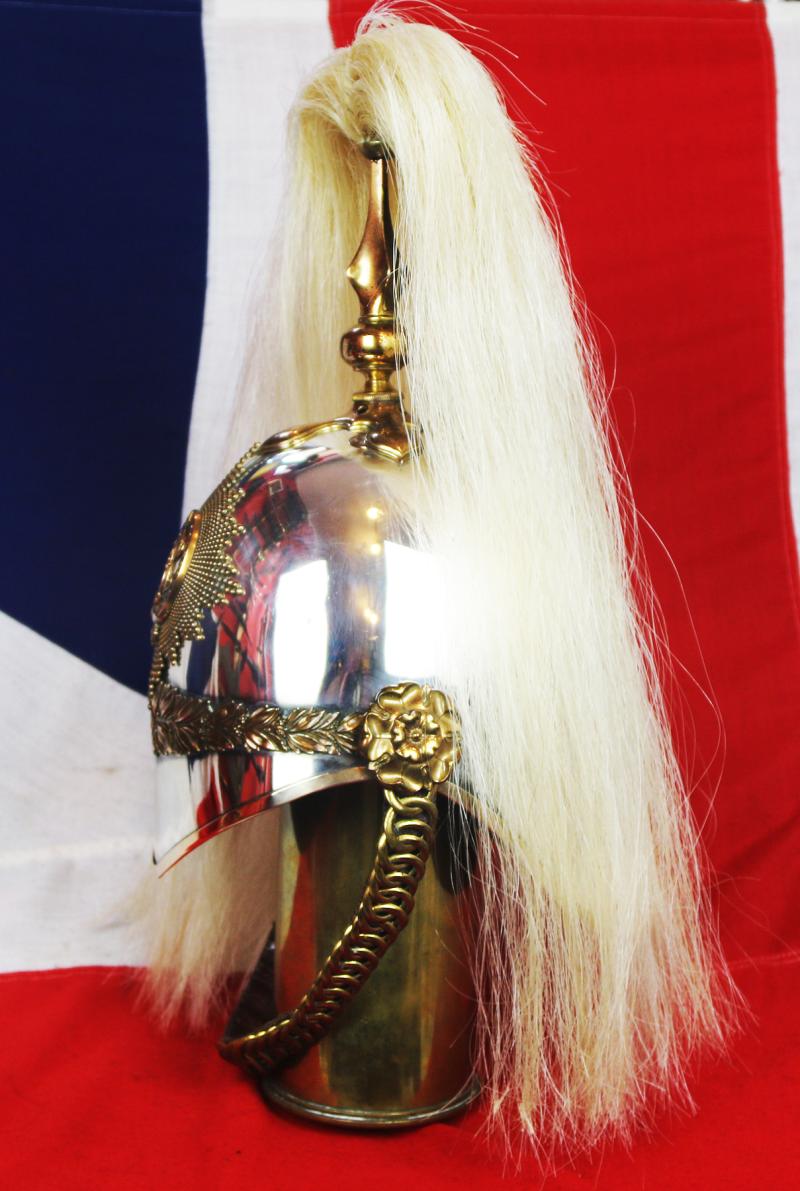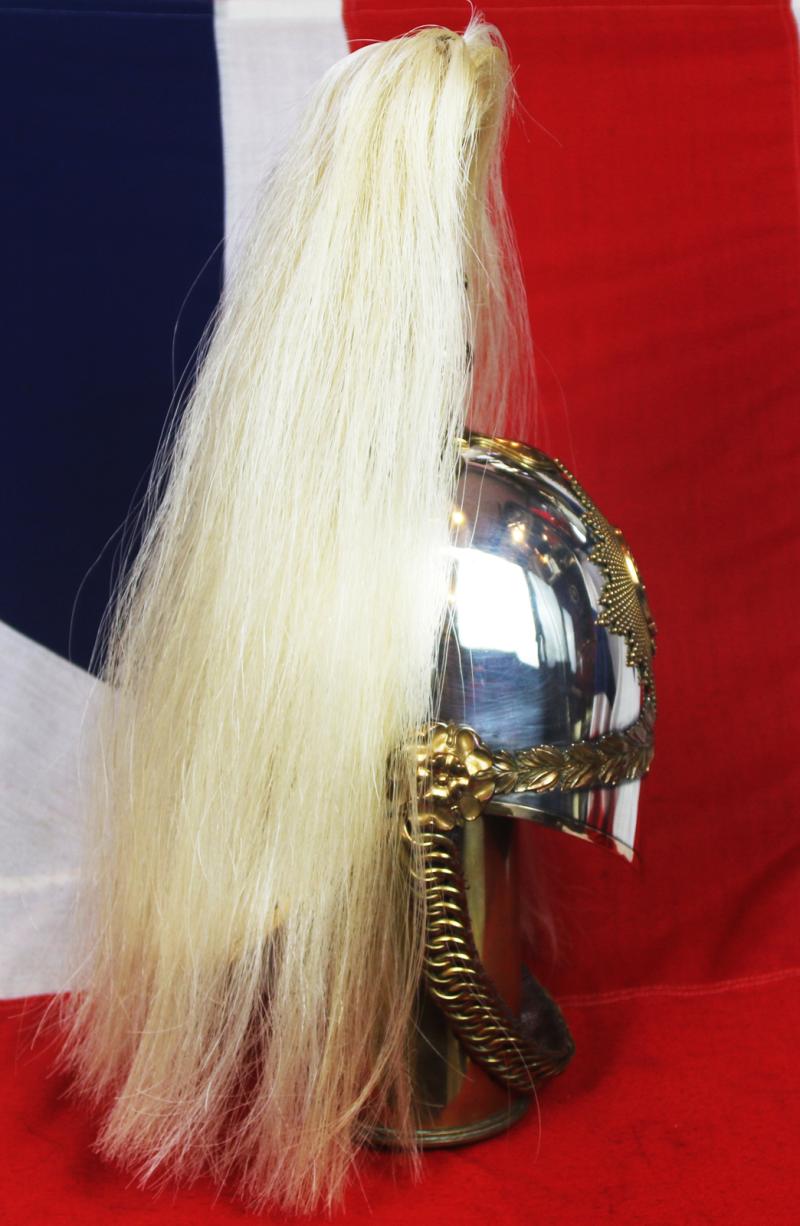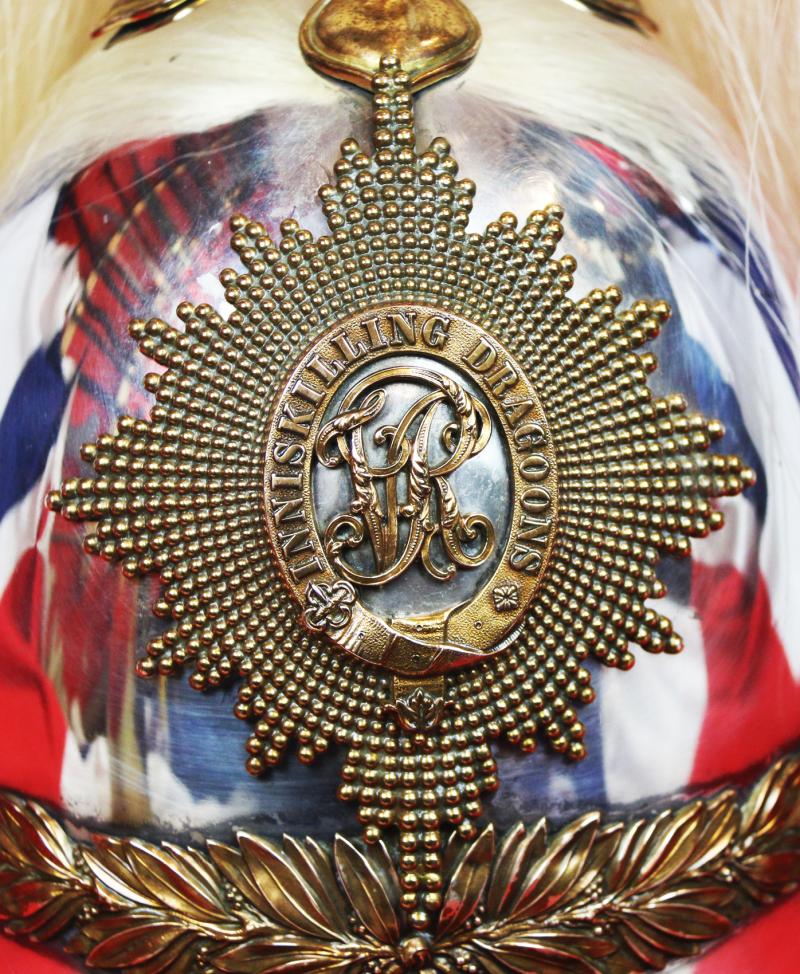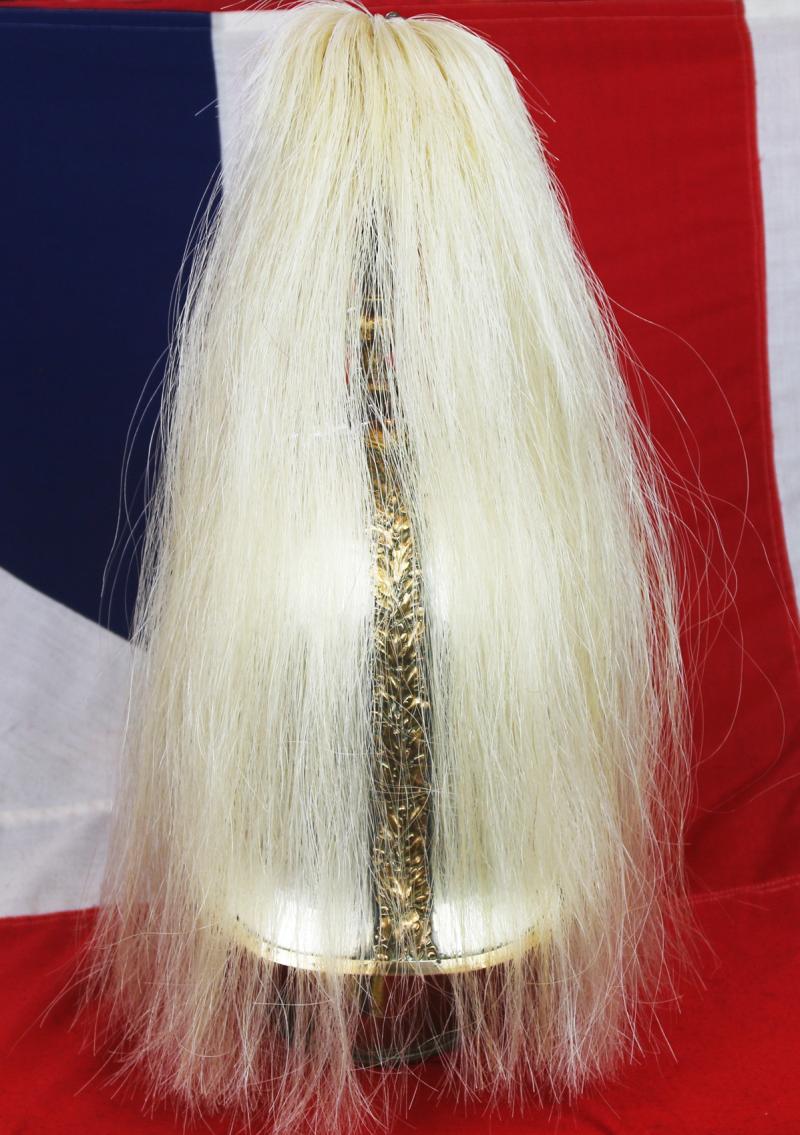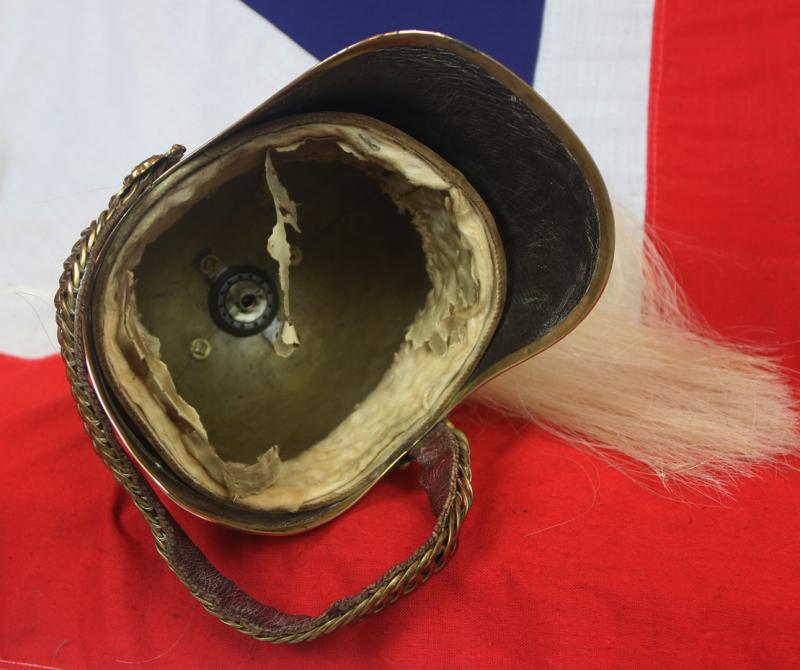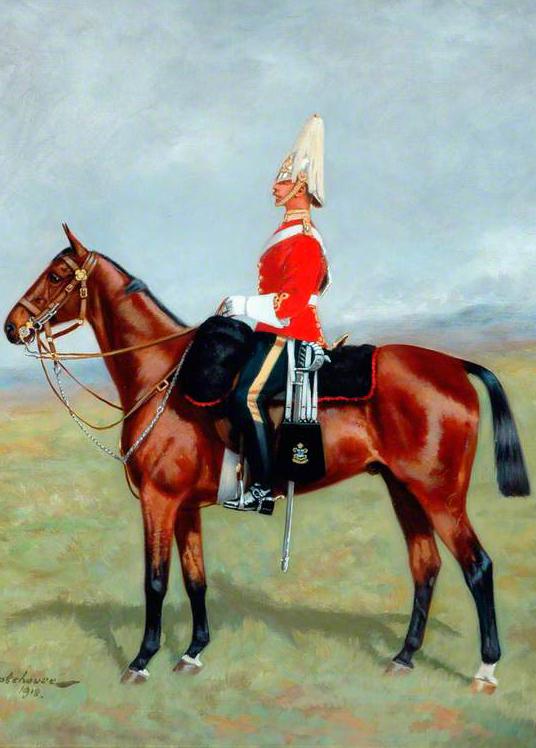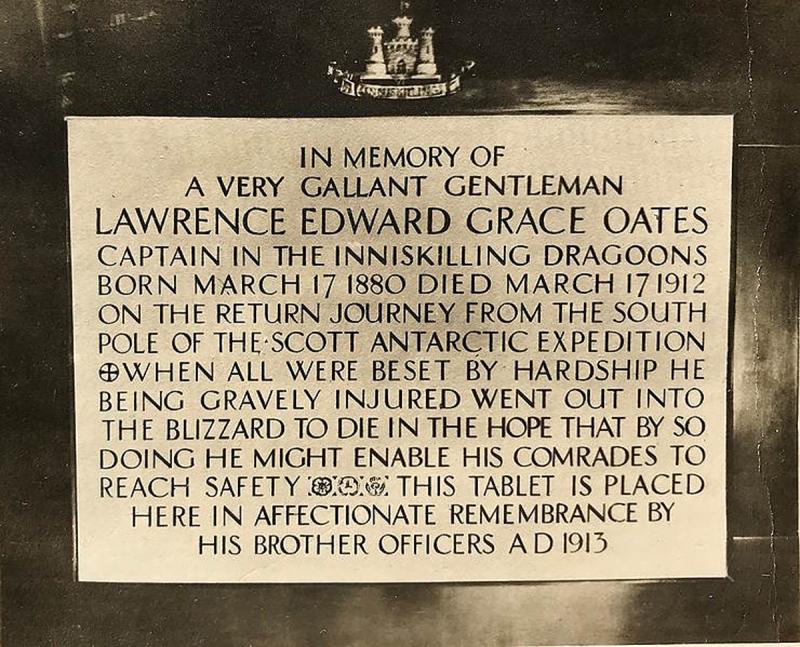A Wonderful, Original, Antique Victorian Officer's Helmet of the Inniskilling Dragoon's. One of the Great Irish Cavalry Regiments in the British Army & One of The Most Desirable of All The Victorian Regimental Helmets. As Worn By Capt. "Titus" Oates
Hero of the 'Terra Nova' Antarctic Expedition of Captain Scott to find and plant the flag on the South Pole. A memorial was placed on the probable location of his demise in Antarctica “Hereabouts died a very gallant gentleman, Captain L. E. G. Oates, of the Inniskilling Dragoons. In March 1912, returning from the Pole, he walked willingly to his death in a blizzard, to try and save his comrades, beset by hardships."
One of the best surviving examples one can see, in or out of a museum. Silver plated skull, copper gilt trim mounts and plume spike, and officer's garter star badge, with oval garter bearing Inniskilling Dragoons, around a central VR cypher over a silver plate. Long white horsehair plume. In superb condition, but only considerable wear to the inner liner.
This is a very scarce totally original British cavalry officers deluxe quality helmet, complete with its original chin scales, which are often lost. The 6th (Inniskilling) Dragoons was a cavalry regiment in the British Army, first raised in 1689 as Sir Albert Cunningham's Regiment of Dragoons. During the Victorian era, it was known as the 6th (Inniskilling) Regiment of Dragoons until 1861, after which it was known as the 6th (Inniskilling) Dragoons.
Exactly the same form of helmet that was used by Victoria Cross nominee and world famous polar explorer, Captain Lawrence "Titus" Oates, a 6th Inniskilling Dragoons officer, from May 1900 as a Lt. It is even possible this might have been his helmet. However, if not, it was unequivocally worn by one of his brother officers. Although made numerous decades before Capt. Oates’ service, these helmets were handed down to future officers for service in the regiment until WW1
In 1898, Oates was commissioned into the 3rd (Militia) Battalion of the West Yorkshire Regiment. He saw active service during the Second Boer War as a junior officer in the 6th (Inniskilling) Dragoons, having been transferred to that cavalry regiment as a second lieutenant in May 1900. He took part in operations in the Transvaal, the Orange River Colony, and Cape Colony. In March 1901 a gunshot wound shattered his left thigh bone, leaving it an inch shorter than the right. Twice called upon to surrender in that engagement, he replied, "We came to fight, not to surrender." He was recommended for the Victoria Cross for his actions and was brought to public attention.
He was promoted to lieutenant in 1902, and left Cape Town for England after peace was signed in South Africa. He was mentioned in dispatches by Lord Kitchener in his final dispatch dated 23 June 1902. He was promoted to captain in 1906, and served in Ireland, Egypt, and India. He was often referred to by the nickname "Titus Oates", after the historical figure, famous for his statement to his friend and expedition leader Scott of the Antarctic,
According to Scott's diary entry of 16 or 17 March (Scott was unsure of the date but thought 17 March correct), Oates had walked out of the tent the previous day into a −40 °F (−40 °C) blizzard to his death. Scott wrote in his diary: "We knew that poor Oates was walking to his death, but though we tried to dissuade him, we knew it was the act of a brave man and an English gentleman." According to Scott's diary, as Oates left the tent he said,
"I am just going outside and may be some time."
Scott, Wilson and Bowers continued onwards for a further 20 miles (32 km) towards the One Ton food depot that could save them but were halted at latitude 79° 40' S by a fierce blizzard on 20 March. Trapped in their tent and too weak and cold to continue, they died nine days later, eleven miles (18 km) short of their objective. Their frozen bodies were discovered by a search party on 12 November; Oates's body was never found. Near where he was presumed to have died, the search party erected a cairn and cross bearing the inscription: "Hereabouts died a very gallant gentleman, Captain L. E. G. Oates, of the Inniskilling Dragoons. In March 1912, returning from the Pole, he walked willingly to his death in a blizzard, to try and save his comrades, beset by hardships."
The regiment also fought with distinction in the Charge of the Union Brigade at the Battle of Waterloo and again as part of the successful Charge of the Heavy Brigade against superior numbers at the Battle of Balaclava during the Crimean War. Unfortunately by WW1, cavalry was very much obsolete, and the many of the legendary cavalry Regiments of Britain were eventually reduced and amalgamated, eventually becoming a single regiment, the Royal Dragoon Guards.
This lovely silver finished helmet dates from the Victorian period, and has the VR royal cypher in the centre of the INNISKILLING DRAGOONS helmet plate on the front of the helmet. The lack of an "I" indicates that this helmet is from before 1876, when Victoria became Empress of India.
They served in the Crimea in 1854, losing all its horses en route in a fire on board its troop ship, but still managing to take part in the charge of the Heavy Brigade at Balaklava.
The regiment was deployed to the Crimea in April 1854 but during the voyage the regiment's transport ship Europa sank with the loss of the commanding officer, Lieutenant Colonel Willoughby Moore, and 17 of his men. Lieutenant-Colonel Henry Dalrymple White took over command of the regiment and led it in action at the Battle of Balaclava in October 1854.
The first assault line consisted of the Scots Greys and one squadron of the Inniskillings, a total of less than 250 sabres. Only when the RSMs declared themselves happy with the alignment did Scarlett order his bugler to sound the 'Charge'. The idea of a charge conjures up images of the Light Brigade dashing forward at speed but Dragoons were larger men with much heavier equipment so their charge was more of a trot. Floundering at obstacles such as ditches or coppices they headed towards the massed ranks of Russian cavalry, pressing on inexorably at a mere 8 miles an hour. Slow they may have been but the effect of these heavy cavalrymen slamming into the much lighter Russian cavalry stunned their enemy. A letter from a Captain of the Inniskillings illustrates the mellee which followed:
"Forward - dash - bang - clank, and there we were in the midst of such smoke, cheer, and clatter, as never before stunned a mortal's ear. it was glorious! Down, one by one, aye, two by two fell the thick skulled and over-numerous Cossacks.....Down too alas! fell many a hero with a warm Celtic heart, and more than one fell screaming loud for victory. I could not pause. It was all push, wheel, frenzy, strike and down, down, down they went. Twice I was unhorsed, and more than once I had to grip my sword tighter, the blood of foes streaming down over the hilt, and running up my very sleeve....now we were lost in their ranks - now in little bands battling - now in good order together, now in and out."
In the words of Colonel Paget of the Light Brigade "It was a mighty affair, and considering the difficulties under which the Heavy Brigade laboured, and the disparity of numbers, a feat of arms which, if it ever had its equal, was certainly never surpassed in the annals of cavalry warfare, and the importance of which in its results can never be known.
It then took on peacekeeping roles in India in 1857 after the Mutiny and in South Africa in 1880 after the Zulu War.
It fought as mounted infantry in the Boer War. After the outbreak of the Second Boer War in October 1899, the regiment was sent to South Africa. It formed part of General French′s force in the operations around Colesberg, and afterwards one squadron took part in the relief of Kimberley in February 1900. The squadrons of the regiment then rejoined, and formed part of the cavalry brigade which served in all the engagements in the general advance on Pretoria, one of the Boer capitals, which was captured on 5 June 1900. They took part in the battles of Diamond Hill (June 1900) and Belfast (August 1900), and in the following cavalry advance on Barberton in the Eastern Transvaal. The regiment subsequently joined a column under the command of Colonel Michael Rimington in the Orange River Colony, taking part in miscellaneous raids and drives there throughout the last year of the war, which ended with the Peace of Vereeniging on 31 May 1902. Following the end of the war, 257 officers and men of the regiment left Cape Town on the SS Orissa, which arrived at Southampton in late October 1902, and another 138 men arrived at Queenstown the following month on the SS Orient.After their return, the regiment was stationed at Curragh. One of its lieutenants, Lawrence Oates, was recommended for the Victoria Cross and is best known for his last words - 'I am going out, I may be some time' - shortly before his death on Scott’s expedition to the South Pole in 1912.
The unit served mainly as infantry on the Western Front during the First World War, suffering heavy casualties on the rare occasions it charged as cavalry.
Officer of the 6th Inniskilling Dragoons painted in 1918 by G. Gatehouse
The painting is now housed in the The Military Museum of the Royal Dragoon Guards
Code: 25405


